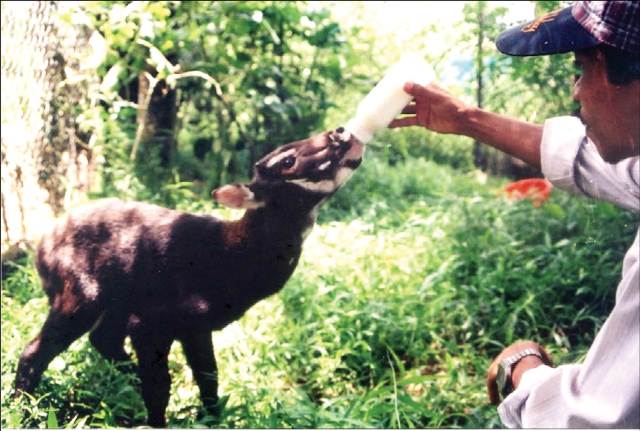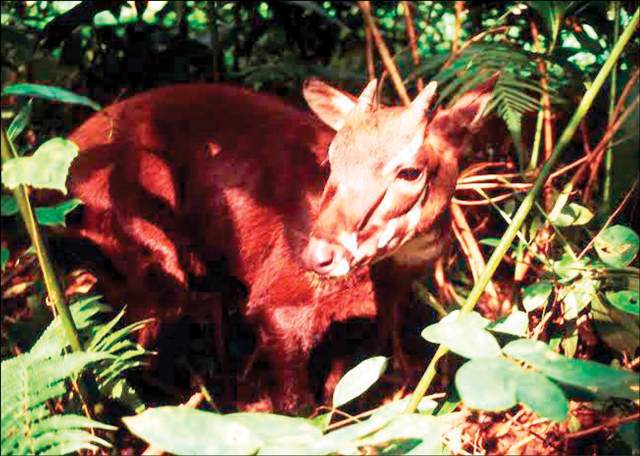Bach Ma National Park (Thua Thien Hue) has been selected by the Ministry of Agriculture and Rural Development (MARD) as the first saola (pseudoryx nghetinhensis) breeding center in the world, in order to save this rare animal. The saola, which is considered by researchers as the “unicorn”, is in danger of extinction.

Saola was discovered in 1999 in Duong Hoa. Photo: WWF
The very rare species
After a long time being considered to be extinct, a saola was first discovered in 1992 during a survey trip to Vu Quang National Park, organized by the World Wide Fund for Nature (WWF) in collaboration with Vietnamese ministries and departments. After searching efforts, they continued to discover 20 more saolas in the same year. At that time, experts and scientists affirmed that the saola was the world's rarest animal still existing in the natural forests of the Truong Son range.
It was not until 1999 that in Ho village, Duong Hoa commune (Huong Thuy town), local people discovered a male saola weighing 52 kg. At the same time, in Huong Nguyen commune (A Luoi, Thua Thien Hue), a pregnant female saola, which was 80kg, appeared. Also in the area of Huong Nguyen commune, they discovered another saola weighing 10 kg one year later. The occurrence of saolas marked a significant "milestone" in the efforts to find this rare species. It not only contributed to the biodiversity in Thua Thien Hue, the Truong Son range but also the world.
Mr. Nguyen Dai Anh Tuan, Director of Provincial Forest Protection Department informed that in 1996-1997, the department had coordinated with domestic and international organizations to conduct hundreds of surveys in order to determine the distribution of the saola in the province. Via some technologies of searching, surveying and tracing, it had been found that the saola has still existed in natural forests in 19 communes of A Luoi, Nam Dong, Phong Dien, and 2 towns of Huong Thuy, Huong Tra.
From the searching efforts and remarkable results, nearly 4 years ago (in late 2013), the Provincial People's Committees decided to establish the Saola Protected Area with an area of over 15.5 thousand hectares. The objectives of the Protected Area was not only to protect the lives of this rare species but also preserve and enhance the biodiversity of natural forests. In the conservation process of the saola, the researchers also discovered 2 species of giant muntjac (muntiacus vuquangensis) and Truong Son muntjac (muntiacus truongsonensis)...
Since the last time one more saola was captured by the local people in 2010 and died a week later. Up to now, researchers as well as the residents have not directly recognized the occurrence of this animal in the nature. Experts and scientists only discovered saolas by camera traps, and found some individuals living in forests in Laos and Vietnam. The latest finding was in 2013, when the WWF discovered the saola in Central Vietnam via camera trapping.

Saola was discovered in 1999 in Huong Nguyen commune. Photo: WWF
Propagation to conserve
Up till now, authorities and scientists have not yet had statistics or determined the specific number of saola existing in the nature. Because of wild animal hunting, the saola is also snared and killed; so the estimated number is only about a few dozen individuals, concentrating the most in the natural forests in the province of Thua Thien Hue.
According to Huynh Van Keo (Ph.D.), Director of Bach Ma National Park, in response to the urgent need, the Saola Working Group (SWG) of International Union for the Conservation of Nature (IUCN) had collaborated with the Ministry of Agriculture and Rural Development to establish the world's first saola breeding program at Bach Ma National Park. This was not only a great honor for Bach Ma National Park, but also an opportunity to preserve this rare species, contributing to the biodiversity in the province.
In the near future, it is necessary to find the saola and consider the breeding then. This is a difficult mission, which requires efforts and supports from both authorities and local people. The biggest difficulty is that the saola is very difficult to approach. This species is in deep forests, the number of individuals is very small. This requires the identification, exploration, zoning and detection solutions being implemented in an efficient and accurate way.
Mr. William Robichaud, Coordinator of the Saola Working Group said that although it was difficult to do so, it must be implemented to save the saola from extinction. Propagation needed to be urgently implemented in early 2018. This plan required the cooperation and mutual supports between domestic and international organizations. Mr.William Robichaud optimistically said that the conservation and propagation of saola were absolutely possible if there was dedication and efforts.
Van Ngoc Thinh (Ph.D.), Director of WWF Vietnam believed that with the enthusiasm and responsibility of domestic and international nature conservation organizations, the saola would be discovered and bred in the soonest time. In addition to the efforts of experts through modern technologies, the support from the local people in discovering the saola was also needed.
By Hoang Trieu